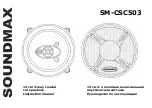
0
NHT
iC4 ARC In-Ceiling Loudspeaker Installation Guide
volume should be decreased ASAP.
- Speaker damage most often occurs from sustained high volume levels, not from transient sounds or brief musical peaks.
- Excessive boosting of bass, treble or equalizer controls can worsen the problem, and is not recommended.
- Having more power is always better than having less. Underpowered amplifiers are most often the cause of speaker damage.
- If you tend to listen at higher volume levels, get a powerful amplifier because they are less likely to run out of power.
- Proper wiring of the speakers is critical to good sound - speaker wires have some sort of marking along one or both conductors to help
you make the correct connections.
- Weak bass and the lack of a well-defined stereo image indicate incorrect speaker phase (the + and – are reversed on one speaker)
Optimizing Sonic Performance
Bass response is smoothest when the speaker is mounted into a rigid ceiling that flexes very little. For improved performance, during
framing, add cross-braces horizontally roughly one and a half feet to either side of the speaker location. Use adhesive caulk and extra
screws when attaching the drywall to the joists around the speaker. Additionally, once the speaker cutout has been made in the drywall,
add a strip of a high-quality non-hardening construction adhesive type caulk where the drywall meets the joists and cross-braces. Also
for more controlled bass response, add (code-approved & fire resistant) insulation to the ceiling cavity around and behind the speaker to
provide acoustic damping. Be sure to add the same amount of insulation to each speaker in the same room to ensure consistent sound.
Use R-2 or R-9 fiberglass insulation, and be sure to wear protective gloves and a breathing mask to avoid contact and inhalation of
the fibers. If the insulation is paper or foil faced, position the paper or foil side away from the speaker. If the new or existing insulation
is the “loose” blown-in type, place a thin sheet of fiberglass over the top of the speaker to keep out small debris.
Maintenance
Do not expose the speakers to direct sunlight or excessively high temperatures.
Do not attempt to clean the actual drivers (speakers) themselves.
You may clean the grill after removal with a citrus-based cleaner to cut a greasy film otherwise a mild detergent will clean the speaker
up nicely. Avoid harsh cleaners. Let dry completely.





























